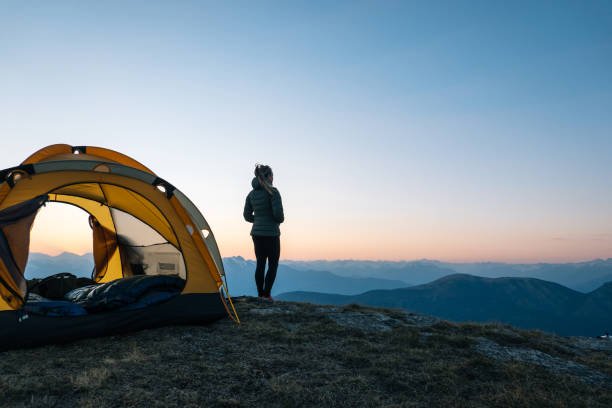Contents
Introduction to Safety Tips for Solo Camping:
Solo camping offers a unique opportunity for adventure and self-discovery amidst the beauty of nature. However, embarking on a solo camping trip also comes with its own set of challenges and risks. Ensuring your safety and well-being during solo camping adventures requires careful planning, preparation, and adherence to essential safety measures.
In this guide, we’ll delve into twelve crucial safety tips specifically tailored for solo campers. From selecting the right campsite to handling emergencies and practicing wilderness survival skills, these tips will equip you with the knowledge and confidence to enjoy your solo camping experience to the fullest while staying safe and secure.
Whether you’re a seasoned outdoor enthusiast or a first-time solo camper, prioritize safety above all else as you embark on your solitary journey into the wilderness. Let’s dive into these invaluable safety tips to ensure a memorable and worry-free solo camping adventure.

Solo Camping Safety Tips
Choosing the Right Campsite
Selecting an appropriate campsite sets the foundation for a safe and enjoyable solo camping trip. Research potential locations, considering factors such as terrain, accessibility, and proximity to water sources. Choose a site with level ground and natural barriers for protection against the elements.
Setting Up Camp Safely
Once you’ve found the ideal spot, ensure a secure camp setup. Pitch your tent on flat ground away from potential hazards like dead trees or rocky outcrops. Secure your belongings to prevent them from being blown away by wind or scavenged by wildlife. Establish a designated cooking area away from your tent to minimize the risk of accidental fires.

Fire Safety
Campfires can provide warmth and ambiance during chilly nights, but they also pose a significant risk if not managed properly. Before starting a fire, clear the surrounding area of debris and flammable materials. Always keep a bucket of water or sand nearby for extinguishing the flames, and never leave a fire unattended.
Food Safety
Proper food storage and preparation are essential to prevent foodborne illnesses while camping. Store perishable items in airtight containers or a cooler with ice packs to maintain freshness. Cook meals thoroughly to kill harmful bacteria, and wash utensils and cookware with hot water and soap after each use.
Personal Safety
Maintaining personal safety is crucial when female camping alone in remote areas. Carry a whistle or personal alarm for emergencies, and familiarize yourself with basic self-defense techniques. In case of injury or illness, have a plan in place to signal for help or evacuate to safety.

Weather Preparedness
Weather conditions in the wilderness can be unpredictable, so it’s essential to be prepared for various scenarios. Check weather forecasts before your trip and pack appropriate clothing and gear for the forecasted conditions. In colder climates, bring layers of clothing and a waterproof jacket to stay warm and dry.
Navigation Tips
Navigating unfamiliar terrain requires the right tools and skills to avoid getting lost. Carry a map and compass, and practice using them before your trip. Consider investing in a GPS device for added navigation assistance, but always have a backup plan in case of technology failure.

Wildlife Awareness
Encounters with wildlife are a common occurrence in natural habitats, so it’s essential to be aware of potential threats and how to minimize risks. Research the local wildlife species and their behaviors, and take precautions such as storing food properly and keeping a safe distance from animals.
First Aid Essentials
Accidents and injuries can happen when exploring the wilderness, so it’s vital to be prepared with a well-stocked first aid kit. Include essential items such as bandages, antiseptic wipes, pain relievers, and any personal medications. Familiarize yourself with basic first aid procedures before your trip.

Communication Methods
Maintaining communication with the outside world is essential for safety and peace of mind during solo camping trips. Carry a fully charged cell phone or satellite communicator, and inform a trusted friend or family member of your itinerary and expected return date. Check in regularly if possible, especially in areas with limited reception.
Leave No Trace Principles
Responsible camping practices help preserve the natural beauty of wilderness areas for future generations to enjoy. Follow Leave No Trace principles by minimizing your impact on the environment, packing out all trash, and avoiding damage to vegetation and wildlife habitats.
Gear Checklist
Packing the right gear can make or break your solo camping experience. Essentials include a sturdy tent, sleeping bag rated for the expected temperatures, a reliable stove for cooking, and adequate water storage containers. Don’t forget to bring a headlamp or flashlight for nighttime visibility and a multitool for various tasks.

Solo Camping Dos and Don’ts
Before embarking on your solo camping adventure, familiarize yourself with essential dos and don’ts to ensure a safe and enjoyable experience.
Solo Camping Dos: Research and prepare, inform someone of your plans, practice Leave No Trace, stay hydrated, be mindful of wildlife, stay aware, follow campground rules, keep a first aid kit, and enjoy the experience.
Solo Camping Don’ts: Underestimate risks, leave food unattended, ignore weather forecasts, stray from planned routes, rely solely on technology, forget to leave information, disturb wildlife, neglect fire safety, and leave without properly extinguishing your campfire.
Conclusion
Solo camping offersa unique opportunity for self-discovery and immersion in nature’s beauty. By following these safety tips and guidelines, you can embark on a solo camping adventure with confidence, knowing that you’re prepared to handle whatever challenges may arise. Remember to stay vigilant, respect your surroundings, and embrace the solitude and serenity of the wilderness.



Pingback: How to camp Alone| Solo Camping Benefits - The World Camping